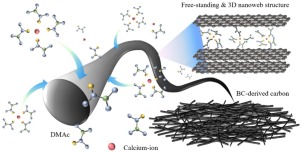
As promising candidates for next-generation batteries, calcium-ion batteries (CIBs) have attracted significant attention because of the lower cost and improved environmental friendliness of Ca metal relative to those of Li and their potential to deliver higher energy densities. However, their practical application has been limited by the lack of an appropriate electrode that can induce fast Ca co-intercalation/deintercalation reactions while providing longer cycle life. In this study, we report bacterial cellulose (BC) with a highly graphitic-like ordered structure as a new and efficient co-intercalation host for multivalent Ca ions. The free-standing BC electrode with unique 3D porous morphology possessed ultra-fast co-intercalation kinetics, much faster than that for a commercial graphite electrode. In addition, we addressed the controversial issue of whether Ca co-intercalation truly occurs in the graphitic layer. It is demonstrated that the co-intercalation is directly dependent on the degree of carbon crystallinity by using various BC electrodes with different crystallinities at regular intervals. Finally, the effect of the ordering of the carbon stacking layer on the co-intercalation chemistry was electrochemically investigated.
